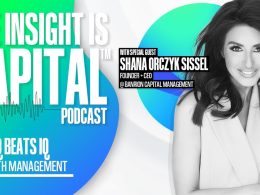Let’s face it—today’s investors are facing more than just the markets. Inflation’s stubborn, global politics are messy, and trust in the financial system is running on fumes. In a wide-ranging and timely conversation1, Sam Febbraro, SVP of Wealth Solutions at Canada Life and President & CEO of Canada Life Investment Management Ltd., joined AdvisorAnalyst’s Pierre Daillie on Insight is Capital to break down the findings of the latest investor sentiment survey2 commissioned by Canada Life and conducted by Abacus Data—and what it means for financial advisors.
The big takeaway? Canadians don’t just want better returns. They want peace of mind. And they’re looking to their advisors to help them feel secure, understood, and ready—no matter what comes next.
Why Performance Isn’t Enough Anymore
Here’s the stat that stopped us in our tracks: while 63% of mutual fund investors say they’re satisfied, only 43% believe their investments will help them hit long-term goals. That disconnect is a flashing red light for the advisory world.
“Trust isn't built on return alone,” says Febbraro. “It's earned by helping people feel safe, supported and prepared no matter what comes next.”
His advice? Shift your lens. ROI matters—but so does ROL: Return on Life. It's about aligning investment strategies with what really matters to clients—their goals, values, and fears—not just their balances.
Segregated Funds: Bumpers for the Bowling Lane
The survey data , for example, shows that investors with segregated funds are more confident across the board. Why? Because seg funds offer structure, safety nets, and clarity in a world where none of those things feel guaranteed.
“Segregated funds offer what many investors may be looking for right now,” Febbraro explains. “They still need to grow their capital, but they perhaps want some guardrails.”
Think of it like putting bumpers on the bowling lane—your clients still play the game, but you’re making sure they don’t end up in the gutter. Canada Life’s seg fund lineup includes:
- Maturity and death benefit guarantees
- Optional death benefit resets that “lock in your clients investment growth each year”
- Potential creditor protection for small business owners
- Estate planning perks that skip probate and simplify inheritances
- access to a broad roster of some of the most well-known PMs and sub-advisors in Canadian and global investment management
And as Febbraro notes, these features are especially powerful in the context of the upcoming $1.2 trillion intergenerational wealth transfer in Canada.
The Real Barrier: Financial Literacy, Not Just Risk
There’s a whole group of Canadians still sitting on the sidelines—confused, hesitant, and overwhelmed. The top three reasons? They don’t understand how investing works, they’re afraid of losing money, and they’re unsure where to start.
This is where advisors make the biggest impact.
“Canadians need clear personalized education,” Febbraro stresses. “About 52% would love to hear an explanation of risk and return. 48% want to understand fees.”
Daillie chimes in from personal experience: “There were probably dozens of times… where I was explaining things to a client without considering their financial literacy.” And clients often stay silent out of fear of sounding uninformed.
The fix? Slow down. Ask better questions. Invite “stupid” ones. And stop tossing around acronyms and jargon that alienate instead of connect. Or as Febbraro puts it: “How many times in our industry do we even use acronyms, never mind some of these ‘five dollar’ words?”
Fees, CRM3, and the Real Value of Advice
Survey data shows only 55% of investors are satisfied with fees—but just 9% are truly concerned. This tells us something powerful: if clients see the value, they’re okay with the cost.
“Transparency always wins,” Febbraro says. “In the absence of value, price is an issue.”
So what’s the advisor’s role in the CRM3 world? To spotlight what clients are really paying for: peace of mind, planning expertise, and consistent guidance through complexity. Febbraro reminds us: “You could argue, how does anyone put value or a price tag on that?”
Daillie agrees, describing the advisor’s network as a “compounded knowledge” model—built on estate planners, insurance specialists, and other financial professionals working together. The more advisors shine a light on this network, the easier it is to justify the fee—and elevate the client relationship.
Scarcity vs. Precarity: Understanding the Shift in Mindset
Febbraro makes a subtle but important distinction that cuts to the heart of how clients are feeling right now:
- Scarcity is asking, “Will I have enough?”
- Precarity is asking, “Will I be okay?”
And that shift—from not just lack, but instability—demands a different kind of support. Clients want more than performance. They want to feel like they’re not alone in navigating the unknown.
“Scarcity is about spending less,” Febbraro adds. “Precarity is about spending differently.”
So, what can advisors do? Keep plans current. Talk through life stages. Clarify risk tolerance in plain language—not as a compliance check, but as a conversation. As Daillie jokes, “What is your risk tolerance?… Like, how do I want to lose money?”
That’s the tone clients resonate with—human, honest, and relatable.
Advice That Actually Matters
As they wrap, Febbraro offers a heartfelt reminder to every advisor:
“Never forget the value that [you] bring to Canadians each day… I see [advisors] as chief financial officers of the family unit.”
And whether you're acting as a quarterback, a board member, or a trusted partner through life’s transitions, that role has never been more important.
“Focus on resilience. Focus on outcomes,” he says. “Focus on the life your clients want to build.”
Listen on The Move
Source:
1 Sam Febbraro, “Inside the Minds of Canadian Investors: Survey Findings Every Advisor Should Know” Insight is Capital, July 21, 2025
2 Abacus Data. Survey: Confidence, Clarity, and Control: Building a Stronger Future for Mutual and Segregated Funds." Canada Life–Abacus Data, July 18, 2025
















